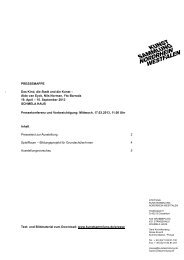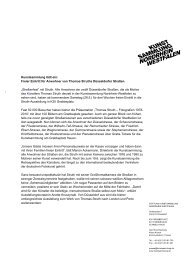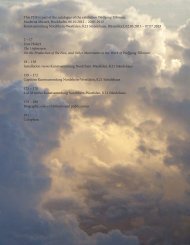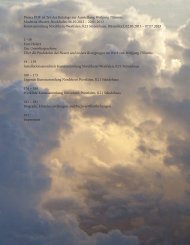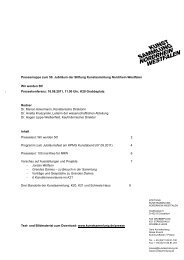Download online catalog (pdf)
Download online catalog (pdf)
Download online catalog (pdf)
Create successful ePaper yourself
Turn your PDF publications into a flip-book with our unique Google optimized e-Paper software.
to be constantly alert here. In contrast to such dreamlike-desolate night scenes, Neue Welt<br />
also contains memorable sunlit tableaus. A double spread of an epic market scene in Ethiopia<br />
looks like a perfectly arranged stage set or a realist painting from the nineteenth century, as<br />
though you could never in fact chance on such a balanced, multi-layered scene in real life. This<br />
picture of traders on dusty ground, this image with its complex web of gestures, poses, gazes,<br />
colours (above all in the garments and clothing) and the plunging diagonals around which the<br />
players are all grouped, looks like the vanishing point (forwards or backwards) of the many<br />
images of rooms and buildings of the globalised economy, the gleaming chrome-finished<br />
and granite-clad shopping malls, of speculative architecture, of shopping streets with huge<br />
billboards or of people in shops stuffed with merchandise that we see in Neue Welt. In this<br />
volume the photographs also reflect a heightened interest in materiality, in the sleekness and<br />
edginess of commercial architecture and in urban scenarios in the non-places of globalised<br />
society. It is a <strong>catalog</strong>ue of textures – metallic paints, fake façades, glass and synthetics. Time<br />
and again, pictures of car headlights, faceted and polished like insects’ eyes or primeval druzes<br />
and geodes. Dangerous-looking, futurist-archaic forms found in some underground car park<br />
in Tasmania, where Tillmans experienced something of an epiphany at the sight of recent<br />
car design in all its grotesqueness. Or this unsettling still life: a mercilessly grasping claw at<br />
a rubbish tip; a heap of jetsam that one is as keen to avoid cutting oneself on as on the sharp<br />
shells of crustaceans lying on a table that seem to point to a hastily consumed meal. A parade<br />
of disparate, heterogeneous materialities and textures, alternating with portraits of men in<br />
work outfits and leisure clothing, of Wolfgang Tillmans’ partner Anders Clausen, of the aged<br />
Gustav Metzger, who – like Nonkosi Khumalo – was seen in the first room of the Warsaw<br />
exhibition. Tillmans presents glimpses of highly technologised workplaces, of an operating<br />
theatre and an observatory. He photographs the night sky above Kilimanjaro, but draws attention<br />
to the digital noise of the shot and thus foils any expectations viewers might have had of a<br />
National Geographic aesthetic.<br />
And he homes in on upper arms, napes of necks and folds in clothes. These are familiar<br />
visual gestures, there are some quite astonishing continuities that initially may not seem<br />
entirely in keeping with a book title promising a new world, until it becomes clear that the<br />
movements in this body of work occur less in connection with motifs than in the sometimes<br />
imperceptible changes in photography with regard to its technical and historical possibilities<br />
and in the changes in the relationship that the artist has with his own medium.<br />
Latent Pictures<br />
In Neue Welt Tillmans’ photographic practice becomes even more differentiated than before.<br />
It is not merely a document of his handling of digital technology, of his new-found delight in<br />
the crassness and harshness of global junkspaces that can be represented and refined in highdefinition<br />
mode very differently to what was possible using analogue equipment. Significantly,<br />
above all in the first half of the book, he has interspersed the camera shots with images from<br />
the Silver series, possibly his most difficult, least accessible group of works. For these works<br />
are not only bereft of easily recognisable and explicable figurative elements, they also lack the<br />
gestural aspect of the Freischwimmer and the three-dimensional corporeality of the creased<br />
and folded Lighter images. Tillmans uses the stock colours from various colour photo paper<br />
manufacturers, manipulates the chemical processes in the dark room by working with used<br />
or impure developing fluids and uses the correspondingly dirtied rollers in the developing<br />
equipment, so that debris and other mechanical traces are left on the surface of the paper. As a<br />
result these images often appear strangely dry and dull, despite the fact that they are endlessly<br />
nuanced in their morphology and give a vivid account of the phenomenon (and the process)



